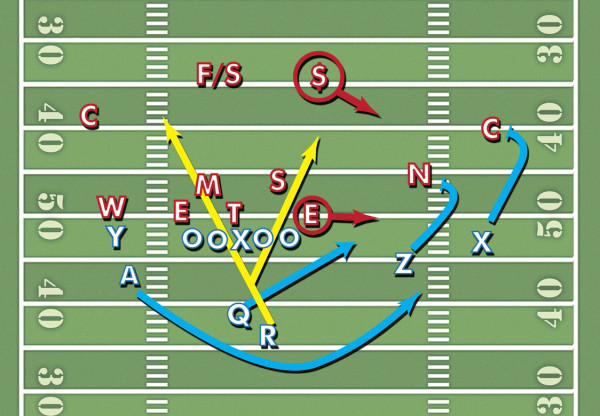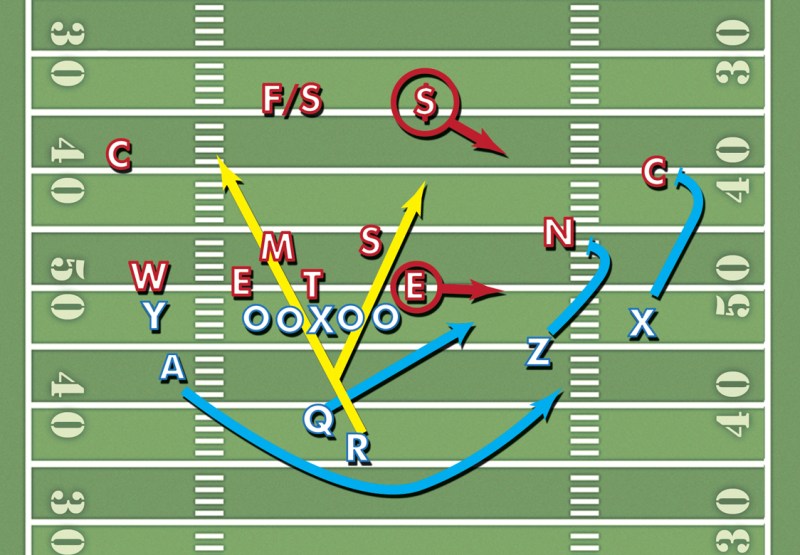“Screens.” To a football announcer calling Stanford, no word is more ubiquitous, and to a Stanford fan, no word is more irritating. Stanford has seen nearly every kind of screen you can imagine. Bubble screens, tunnel screens, flare screens and slow screens — short passes thrown behind the line of scrimmage rather than downfield strikes. For a conference that prides itself on its tactical diversity, it is entertaining to see just how homogenous Stanford’s opponents have been for the last two years.
Recently, Arizona, Washington State, Oregon, UCLA, San Jose State, Arizona State, Washington and now Utah have all utilized approximately the same strategy against the Cardinal. Over time, the “Stanford formula” has evolved, culminating in the end of Stanford’s 13-game winning streak this past Saturday against Utah. As a result, the Cardinal faithful should expect to see the same strategies again and again.

It was clear from Utah’s very first drive that the Utes were committed to the screen-option game. Before I continue, let’s make this clear: What Stanford has been seeing isn’t a gimmick, nor is it new. In the spread-option, the offense spaces its receivers to spread out the defense and open up lanes for the option run game. With screen passes effectively being runs, the spread option allows the offense to run from all over the field. Ironically, the screen pass was actually invented by Pop Warner at Stanford.
The beauty of this offense is that if four receivers are utilized in the passing game to block four defensive players and the defense keeps a safety downfield to avoid big plays (as displayed in the diagram), the offense has five offensive linemen against six defenders in the tackle box. If the two players in the backfield can option off one defender by running the ball where the defender is not, the blocking is five on five, meaning that there is nobody left in the immediate vicinity to tackle the runner. This leads to a steady diet of 5- to 7-yard runs. To further the defensive disadvantage, if the lone safety drops to provide run support, the offense has an advantage on the perimeter with the screen game.
Under Mike Bellotti, Chip Kelly and now Mark Helfrich, this version of the spread option made Oregon famous. In 2011, Oregon shredded Stanford 53-30 with a spread option attack, but curiously enough, teams did not catch on.
Appropriately, the anti-Stanford strategy found its genesis with the original architect of the spread option, Arizona’s Rich Rodriguez. In October 2012, Rodriguez began with a more traditional offensive game plan. However, Stanford shut down the Arizona run game, and under relentless pressure from the Stanford front seven, quarterback Matt Scott took hits that would have sent many people to the hospital. In response, Rodriguez started calling quick bubble screens to the outside, and with Stanford’s safeties focusing on the run game, Stanford surrendered a staggering 617 yards, of which the vast majority were through the air.
Stanford’s defensive coordinator Derek Mason promised changes after the Arizona debacle and six weeks later, Mason’s defense scored a massive triumph against Oregon, holding the vaunted Ducks offense to 14 points. By playing “quarters” coverage (a cover 4), Stanford’s safeties had more support in the passing game, giving them more freedom to read and react — they could attack the run game and play the pass simultaneously. Quarters is not the only coverage Stanford uses, but Stanford has used it extensively since the game against Oregon. In the play diagrammed, Stanford is in what looks to be quarters.
Offenses evolve, as they are wont to do, and in the 2012 Pac-12 Championship Game, UCLA took Stanford to the wire, stringing up several long drives and racking up 461 yards. The Bruins’ innovation was motion: By sending receivers in pre-snap orbit motion (e.g. what Utah’s A is doing in the diagrammed play), UCLA gained the ability to shift players from side to side, changing the mathematics of the game as the ball was being snapped. The motion forced Stanford’s safeties to respect the swing pass instead of first reading and reacting, effectively destroying the quarters look. It’s easy to imagine Utah’s coaches watching this game with big grins on their faces.
Here against Utah, if junior strong safety Jordan Richards hadn’t shifted to cover the A, the Utes would have had a three-on-two advantage on the flare screen that might have gone for a touchdown. But Richards also took himself out of the run game by doing so — he had effectively been blocked without actually having been blocked. Stanford was back to square one.
With Richards out of the play, Utah’s quarterback and running back optioned off a defender and the running back took the ball and ran left. With a huge five-on-four advantage in the tackle box, Utah’s offensive line had no problem double-teaming Stanford’s defensive linemen and sealing Stanford’s linebackers away from the play. In this case, Utah’s right tackle Siaosi Aiono had nobody in front of him, hit the second level of the defense immediately and pushed Shayne Skov out of the play, allowing running back Bubba Poole to cut back for a 21-yard gain. Poole would go on to gash the Cardinal for 111 yards on 22 carries, most of his yardage coming on plays like this.
The Utah game was not typical. Stanford’s defensive line was horrendously banged up, and without the protection that defensive penetration affords, Utah’s offensive line had no problem blocking Stanford’s linebackers. Utah is also a good team that would likely have beaten No. 9 UCLA but for a spate of fluky interceptions. But the fact remained that Utah ran all over Stanford, and it was brutally clear that Stanford would have to adapt. Mason changed his tactics as the game went on, bringing more pressure to bear on Utah’s backfield and playing man coverage to free up the safeties. With the game still close, the Cardinal successfully forced several three-and-outs that almost brought the team back from the brink. But these efforts were not enough, and Stanford was shocked in Salt Lake City.
Contact Winston Shi at wshi94 ‘at’ stanford.edu.
